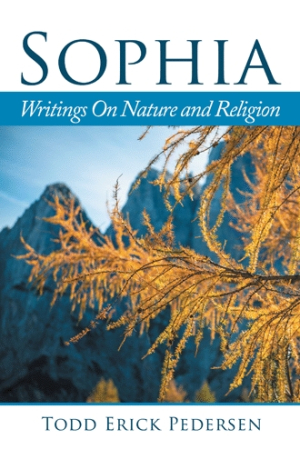Sophia
Writings on Nature and Religion
Pedersen’s writing is hopeful and peaceful, with strong themes of love and generosity.
Todd Erick Pedersen helps discover new ways of thinking about nature in his book, Sophia: Writings on Nature and Religion, a series of thoughtfully written essays and prose poems centered around the concept of “holy wisdom,” or “ayasofya.”
Beyond a brief introduction, the book features 130 essays, some of them a page or two in length, some just a few paragraphs or sentences. They are presented in no particular order. Each explores a different aspect of nature and/or religion. The introduction lays the groundwork with the idea of each person having three “houses”—a physical house, a soul, and a spiritual center.
The overall tone of Pedersen’s writing is hopeful, peaceful, with strong themes of love and generosity. It is not typical conservative or fundamental religion that’s presented here (traditional religion would probably find this New Age-y), though there are many Biblical references: Adam and Eve, leviathan, the words of Jesus. In fact, the importance of hope is explored in a discussion of religion vs. spirituality. “In common they both have, of course,” he writes, “a tendency to underscore essential values like those of meaning, purpose, kindness, compassion, trust in a greater mystery and design, and an unassailable confidence in the irreducibly inestimable value of the human soul.”
With so many short, independent essays, the book is an easy read. There is often a lack of complete sentences, and periods are used more as pauses or for effect, but in the prose poems, this is a stylistic decision that does not interfere with the text. The essays tend to be thick, though there are some simple concepts presented, too: The richness of fall, for instance, as “the flavor of wood smoke, of mixed pine with cedar, rolls its way in layers through the rich golden dale.” Also, the idea that we surrender self during meditation in order to become more than ourselves. Particularly lovely is the entry titled “The Orange Grove,” which draws the image of a young girl picking oranges and giving them to friends, family, and strangers passing by, each person taking home not only an orange, but also her smile and something of her joyful afternoon.
Then there is the idea of God guiding us: “But the truth that is there for the taking, and that exists as a promise to every man, is really in itself so much peacefulness and wonder and joy and possibility and light.”
This is a work that’s best approached in a quiet place cleared for contemplation, and with an open mind. This book will appeal to the analysts of the world, those who are truly introspective.
Reviewed by
Billie Rae Bates
Disclosure: This article is not an endorsement, but a review. The publisher of this book provided free copies of the book and paid a small fee to have their book reviewed by a professional reviewer. Foreword Reviews and Clarion Reviews make no guarantee that the publisher will receive a positive review. Foreword Magazine, Inc. is disclosing this in accordance with the Federal Trade Commission’s 16 CFR, Part 255.

